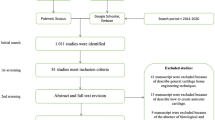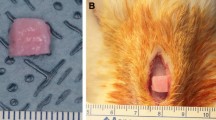Abstract
The role of three-dimensional (3D) printing has expanded in diverse areas in medicine. As plastic surgery needs to fulfill the different demands from diverse individuals, the applications of tailored 3D printing will become indispensable. In this study, we evaluated the feasibility of using 3D-printed polycaprolactone (PCL) scaffold seeded with fibrin/chondrocytes as a new dorsal augmentation material for rhinoplasty. The construct was surgically implanted on the nasal dorsum in the subperiosteal plane of six rabbits. The implants were harvested 4 and 12 weeks after implantation and evaluated by gross morphological assessment, radiographic imaging, and histologic examination. The initial shape of the implant was unchanged in all cases, and no definite post-operative complications were seen over the 3-month period. Radiologic evaluation confirmed that implants remained in the initial location without migration or extrusion. Histologic evaluations showed that the scaffold architectures were maintained with minimal inflammatory reactions; however, expected neo-chondrogenesis was not definite in the constructs. A new PCL scaffold designed by 3D printing method seeded with fibrin/chondrocytes can be a biocompatible augmentation material in rhinoplasty in the future.









Similar content being viewed by others
References
Baker, S. C., G. Rohman, J. Southgate, and N. R. Cameron. The relationship between the mechanical properties and cell behaviour on PLGA and PCL scaffolds for bladder tissue engineering. Biomaterials 30(7):1321–1328, 2009.
Berghaus, A., and K. Stelter. Alloplastic materials in rhinoplasty. Curr. Opin. Otolaryngol. Head Neck Surg. 14(4):270–277, 2006.
Bermueller, C., S. Schwarz, A. F. Elsaesser, J. Sewing, N. Baur, A. von Bomhard, M. Scheithauer, H. Notbohm, and N. Rotter. Marine collagen scaffolds for nasal cartilage repair: prevention of nasal septal perforations in a new orthotopic rat model using tissue engineering techniques. Tissue Eng. Part A 19(19–20):2201–2214, 2013.
Chaim, I. A., M. A. Sabino, M. Mendt, A. J. Muller, and D. Ajami. Evaluation of the potential of novel PCL-PPDX biodegradable scaffolds as support materials for cartilage tissue engineering. J. Tissue Eng. Regen. Med. 6(4):272–279, 2012.
Cingi, C., A. Calli, N. Erdogmus, C. Calli, I. Yilgor, E. Yilgor, and C. Bal. Two new polymers as candidates for rhinoplasty allografts: an experimental study in a rabbit model. Ann. Otol. Rhinol. Laryngol. 122(7):474–479, 2013.
Cologlu, H., A. Uysal, U. Kocer, Y. Kankaya, M. Oruc, and S. Uysal. Rhinoplasty model in rabbit. Plastic Reconstr. Surg. 117(6):1851–1859, 2006.
Dash, T. K., and V. B. Konkimalla. Poly-small je, Ukrainian-caprolactone based formulations for drug delivery and tissue engineering: a review. J. Control. Release 158(1):15–33, 2012.
Daudt, 3rd, D. R., B. Mueller, Y. H. Park, Y. Wen, and T. Yorio. Methylene blue protects primary rat retinal ganglion cells from cellular senescence. Investig. Ophthalmol. Vis. Sci. 53(8):4657–4667, 2012.
El-Ayoubi, R., C. DeGrandpre, R. DiRaddo, A. M. Yousefi, and P. Lavigne. Design and dynamic culture of 3D-scaffolds for cartilage tissue engineering. J. Biomater. Appl. 25(5):429–444, 2011.
Esposito, A. R., M. Moda, S. M. Cattani, G. M. de Santana, J. A. Barbieri, M. M. Munhoz, T. P. Cardoso, M. L. Barbo, T. Russo, U. D’Amora, A. Gloria, L. Ambrosio, and E. A. Duek. PLDLA/PCL-T scaffold for meniscus tissue engineering. BioRes Open Access. 2(2):138–147, 2013.
Greene, J. J., and D. Watson. Septal cartilage tissue engineering: new horizons. Facial Plastic Surg. 26(5):396–404, 2010.
Jeong, C. G., and S. J. Hollister. A comparison of the influence of material on in vitro cartilage tissue engineering with PCL, PGS, and POC 3D scaffold architecture seeded with chondrocytes. Biomaterials 31(15):4304–4312, 2010.
Kafienah, W., M. Jakob, O. Demarteau, A. Frazer, M. D. Barker, I. Martin, and A. P. Hollander. Three-dimensional tissue engineering of hyaline cartilage: comparison of adult nasal and articular chondrocytes. Tissue Eng. 8(5):817–826, 2002.
Kim, D. Y., J. Pyun, J. W. Choi, J. H. Kim, J. S. Lee, H. A. Shin, H. J. Kim, H. N. Lee, B. H. Min, H. E. Cha, and C. H. Kim. Tissue-engineered allograft tracheal cartilage using fibrin/hyaluronan composite gel and its in vivo implantation. Laryngoscope 120(1):30–38, 2010.
Lee, J. S., J. M. Hong, J. W. Jung, J. H. Shim, J. H. Oh, and D. W. Cho. 3D printing of composite tissue with complex shape applied to ear regeneration. Biofabrication 6(2):024103, 2014.
Lee, M. R., J. G. Unger, and R. J. Rohrich. Management of the nasal dorsum in rhinoplasty: a systematic review of the literature regarding technique, outcomes, and complications. Plastic Reconstr. Surg. 128(5):538e–550e, 2011.
Lee, M., and B. M. Wu. Recent advances in 3D printing of tissue engineering scaffolds. Methods Mole Biol 868:257–267, 2012.
Li, W. J., K. G. Danielson, P. G. Alexander, and R. S. Tuan. Biological response of chondrocytes cultured in three-dimensional nanofibrous poly(epsilon-caprolactone) scaffolds. J. Biomed. Mater. Res. Part A 67(4):1105–1114, 2003.
Naumann, A., N. Rotter, J. Bujia, and J. Aigner. Tissue engineering of autologous cartilage transplants for rhinology. Am. J. Rhinol. 12(1):59–63, 1998.
Park, S. H., B. H. Choi, S. R. Park, and B. H. Min. Chondrogenesis of rabbit mesenchymal stem cells in fibrin/hyaluronan composite scaffold in vitro. Tissue Eng. Part A 17(9–10):1277–1286, 2011.
Park, S., G. Kim, Y. C. Jeon, Y. Koh, and W. Kim. 3D polycaprolactone scaffolds with controlled pore structure using a rapid prototyping system. J. Mater. Sci. Mater. Med. 20(1):229–234, 2009.
Rotter, N., J. Aigner, A. Naumann, H. Planck, C. Hammer, G. Burmester, and M. Sittinger. Cartilage reconstruction in head and neck surgery: comparison of resorbable polymer scaffolds for tissue engineering of human septal cartilage. J. Biomed. Mater. Res. 42(3):347–356, 1998.
Sajjadian, A., N. Naghshineh, and R. Rubinstein. Current status of grafts and implants in rhinoplasty: part II. Homologous grafts and allogenic implants. Plastic Reconstr. Surg. 125(3):99e–109e, 2010.
Sajjadian, A., R. Rubinstein, and N. Naghshineh. Current status of grafts and implants in rhinoplasty: part I. Autologous grafts. Plastic Reconstr. Surg. 125(2):40e–49e, 2010.
Schubert, C., M. C. van Langeveld, and L. A. Donoso. Innovations in 3D printing: a 3D overview from optics to organs. Br. J. Ophthalmol. 98(2):159–161, 2014.
Shin, Y. S., B. H. Lee, J. W. Choi, B. H. Min, J. W. Chang, S. S. Yang, and C. H. Kim. Tissue-engineered tracheal reconstruction using chondrocyte seeded on a porcine cartilage-derived substance scaffold. Int. J. Pediatr. Otorhinolaryngol. 78(1):32–38, 2014.
Watson, D. Tissue engineering for rhinoplasty. Facial Plastic Surg. Clin. N Am. 17(1):157–165, 2009.
Yannas, I. V. Emerging rules for inducing organ regeneration. Biomaterials 34(2):321–330, 2013.
Yu, M. S., H. S. Park, H. J. Lee, and Y. J. Jang. Histomorphological changes of Tutoplast-processed fascia lata grafts in a rabbit rhinoplasty model. Otolaryngol. Head Neck Surg. 147(2):239–244, 2012.
Acknowledgments
This work was supported by 2013 Ajou University Translational Research Center Fund (Seed type).
Conflict of interest
None.
Author information
Authors and Affiliations
Corresponding author
Additional information
Associate Editor Scott I. Simon oversaw the review of this article.
Rights and permissions
About this article
Cite this article
Kim, Y.S., Shin, Y.S., Park, D.Y. et al. The Application of Three-Dimensional Printing in Animal Model of Augmentation Rhinoplasty. Ann Biomed Eng 43, 2153–2162 (2015). https://doi.org/10.1007/s10439-015-1261-3
Received:
Accepted:
Published:
Issue Date:
DOI: https://doi.org/10.1007/s10439-015-1261-3




